OLEDs and organic electronics lead the pack in research and applications.
Across Europe, research and development is focused on technologies that aren’t currently in volume production and thus are not dominated by manufacturers located elsewhere. In particular, the emphasis is on organic LEDS (OLEDs) and organic electronics, with some work on other technologies.
An exception to this general trend of working on less popular display technologies can be found at Merck KGaA of Darmstadt, Germany. The company is a leading supplier of LCD materials, reportedly with a worldwide market share of more than 50 percent. In a two-step process, Merck first does fundamental research at sites in Germany and the UK, and then sends these results to facilities in Asia, “which are then making the customer-specific developments and bringing it to the customer in a very efficient and quick way,” said Michael Heckmeier, Merck’s senior vice president of liquid crystal research and development.
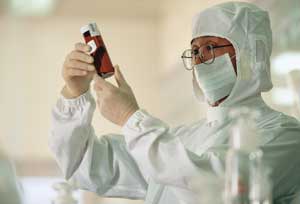
Merck, a pioneer in LCD materials, does fundamental research into new materials in Europe, then refines these results in applications labs in Asia. Courtesy of Merck.
Merck is always working to improve LCD material switching time and optical properties. For example, the company now is developing Blue Phase mode materials, which Heckmeier has predicted could slash response time by a factor of five or more and could appear in commercial displays in the next few years.
As for emerging technologies, the company is involved in small-molecule OLEDs. Chemical similarities between these materials and those in LCDs mean that some synergies exist, Heckmeier said.
For OLEDs, a widely used manufacturing technique involves vaporizing the organic materials and then sending the gas through a mask to make individual pixels. Although this works for smaller screens, it’s not practical for large ones. So Merck is looking to perfect a different technology – one that could economically create displays that span meters.
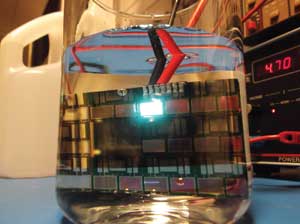
Thanks to encapsulation, a white OLED test device dipped in water functions unharmed. This level of protection is needed to build long-lasting consumer devices. Courtesy of François Templier, CEA-Leti.
“The strategic approach is to develop and design materials that are soluble in inks, in organic solvents, and you can then print these to generate displays,” Heckmeier said.
Such printable display materials are years from mass production, he added. If it can be made to work, an advantage of this approach is that it opens up the possibility of combining OLEDs with organic electronics. The result could be flexible emissive displays that are printed – and can be rolled up – like a newspaper.
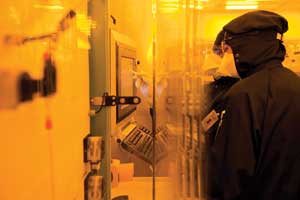
Flexible displays are built in cleanrooms, such as this one in Dresden. Courtesy of Plastic Logic.
A number of other European concerns are involved in OLEDs. The German chemical giant BASF is working to create a stable deep-blue emitter and hopes to launch products based on this within the next few years, said company spokesman Christian Boehme. Another player in this emerging display sector is Cambridge Display Technology, a UK-based subsidiary of Japan’s Sumitomo Chemical that is working on polymer OLEDs.
Yet another mover in the market is privately held startup Novaled AG of Dresden, Germany. The company offers unique p- and n-type dopants as well as matched transport layers, said Tobias Canzler, the team leader for displays and principal scientist at Novaled.
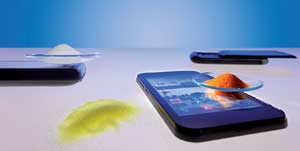
Startup Novaled produces materials for OLEDs that target mobile applications. Courtesy of Novaled.
These features improve the OLED’s electrical characteristics, offering a number of advantages. One is that the material’s lifetime is extended. Another is that overall device yield increases because the OLED’s performance is less sensitive to variations in substrate quality and processing, Canzler said. A third advantage is greater power efficiency, an important consideration in battery-dependent applications.
Looking toward the future, Canzler noted that OLEDs are still much less efficient than LEDs, the more established and inorganic semiconductor-based technology. The issue for OLEDs is that a considerable chunk of the generated light cannot make it out of the device, and this problem is being attacked through material and fabrication changes. The cost-effective manufacturing of large-area displays is another challenge, with hurdles including how to make, and how to drive, those pixels. The belief is that printing or another technique will solve the former, while a metal-oxide backplane will help the latter.
“There is currently a big hope that metal-oxide backplane and AMOLED [active-matrix OLED] will become a perfect match for each other and evolve together,” Canzler said.
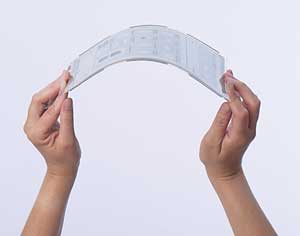
Active-matrix OLEDs are yielding flexible displays that can be used to make electronic textbooks. Courtesy of Plastic Logic.
The need for a backplane in active-matrix OLEDs points to the possibility of a less than promising future for display manufacturing in Europe, even if the Continent becomes a leader in emerging technologies. Active-matrix backplanes selectively turn pixels on or off, giving rise to video, images and text. These backplanes tend to be complex and often require specialized know-how and tooling for inexpensive volume production. Therefore, it may be that the center of the new display industry will stay in Asia, because that’s where most active-matrix backplanes are built today.
There are counterexamples, though. One is MicroOLED of Grenoble, France. The startup is commercializing OLED microdisplays based on technology from Technicolor SA and CEA-Leti, a leading European micro- and nanotechnology research center. These displays are for near-eye applications, such as high-resolution electronic viewfinders for cameras, head-mounted displays for surgeons, enhanced night-vision equipment for military and security professionals, and possibly high-end portable 3-D displays.
In January of this year, MicroOLED announced a 5.4-megapixel microdisplay with a pixel pitch of 4.7 µm. That allowed the entire display to be squeezed into a 1.55-cm diagonal. This pixel density is as much as three times higher than that enabled by other technologies, leading to better picture quality, said MicroOLED CEO Eric Marcellin-Dibon.
There’s another advantage, he added: “Since we have very high efficiency OLED layers, the power consumption of the microdisplay is much lower compared to the competition. Depending on which competitor, it can range from two times less to three or four times less.”
François Templier, manager of the CEA-Leti display lab in Grenoble, is part of a group that continues research into OLEDs and microdisplays. The technology can achieve low cost by taking a page from the semiconductor approach, with many devices being fabricated on one silicon wafer, he said.
However, the organic nature of OLEDs presents some challenges. Specifically, exposure to air or water can degrade the material and lead to a loss of luminance. This damage can be minimized by encapsulating the organic layers in a protective barrier.
“We are working hard on this task to achieve better performance of the protection and, behind that, better lifetime of the device,” Templier said.
Any scheme must not only protect the layers but also be cost-effective in mass manufacturing, he added. The lifetime of an OLED is defined as the time it takes for its brightness to fall 50 percent. Templier put that right now as around 5000 hours, enough for targeted microdisplay applications. However, it’s quite a bit shorter than the 10,000 hours or more that a TV, for example, would demand.
Other novel and non-OLED displays are also under development in Europe. One is from Liquavista, an Eindhoven, Netherlands-based subsidiary of Korea’s Samsung Electronics. This approach is based on electrowetting, which uses voltage to modify the wetting properties of a solid material. When used with a colored oil film held in a cell to form a pixel, the resulting optical stack can be tuned from a colored off-state to a transparent on-state. These switching pixels form the basis for a display, which the company plans to make first for e-readers and then for phones.
Another display technology comes from Plastic Logic GmbH of Dresden, Germany. The company’s low-temperature process of printing, spraying and lithography of organic semiconductors yields an active-matrix thin-film transistor array on plastic. This is combined with Hsinchu, Taiwan-based E Ink’s reflective media to create a display that has the look and feel of paper. The result has already been turned into a product, an electronic textbook. It is debuting in Russia, thanks to an agreement between Plastic Logic and the Moscow-based Russian Corporation of Nanotechnologies.
Peter Fischer, Plastic Logic’s vice president of process engineering, noted that the textbook replacement measures 27.2 cm on a diagonal, weighs 475 g, is 7.65 mm thick and runs for a week without recharging. Also, it withstands drops, spills, dirt and grime.
“Our display technology enables us to build reading devices for paper replacement in industries and business, where huge amounts of paper are used on a daily basis,” Fischer said in speaking of potential markets.
There’s a lot of display activity going on in Europe, noted Myrddin Jones, chairman of the UK chapter of the Society for Information Display. The international organization is for professionals working in display research, design, manufacturing, applications, marketing and sales.
Even as universities and companies are carrying out amazing research, local and national governments are making concerted efforts to foster development of the regional display industry. However, all of this activity is not guaranteed to translate into mass production. “The challenge has been converting that to high-volume manufacturing in Europe,” Jones said.